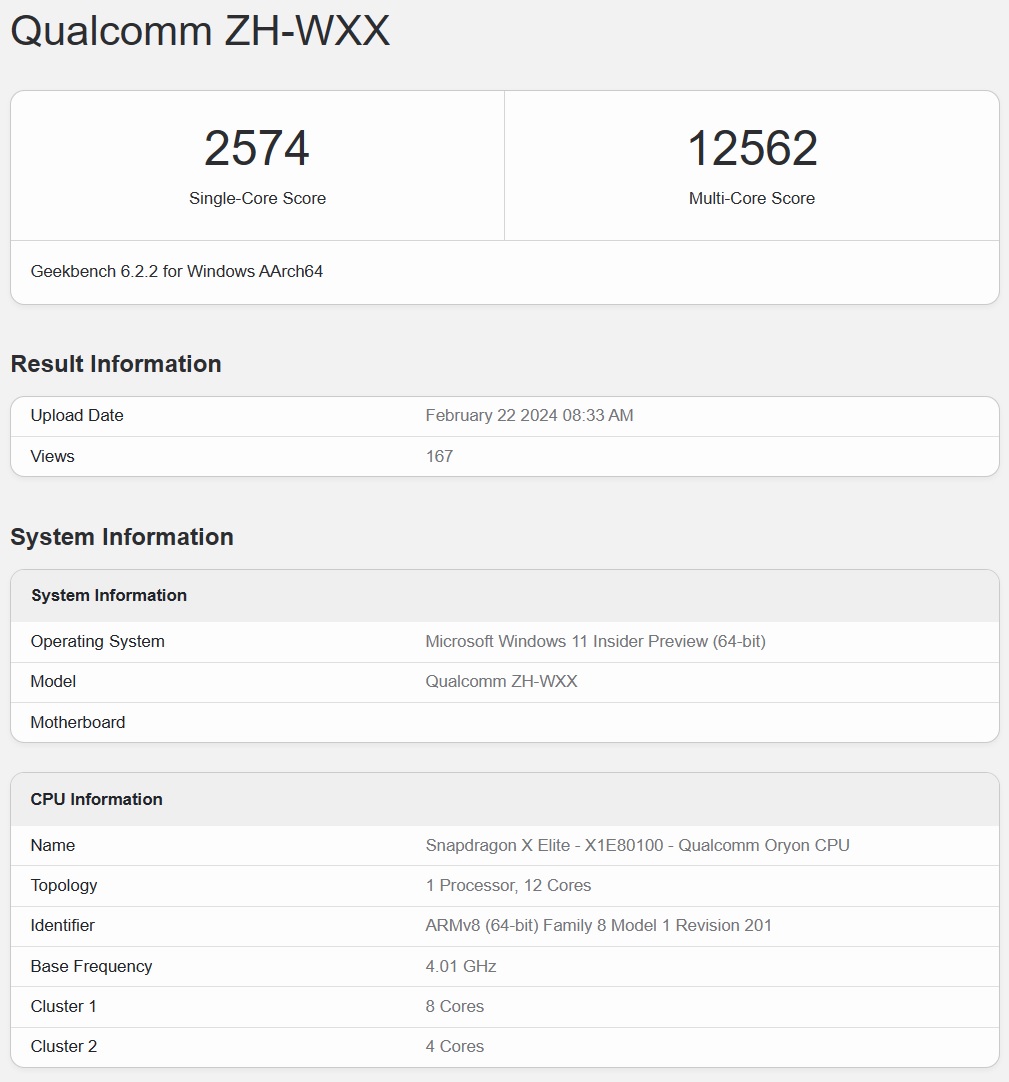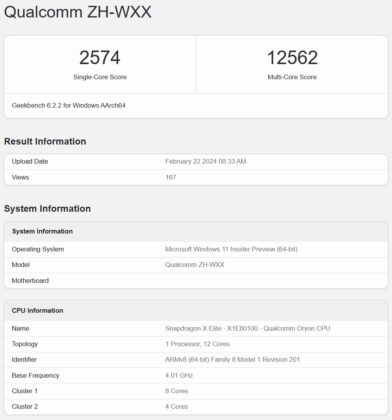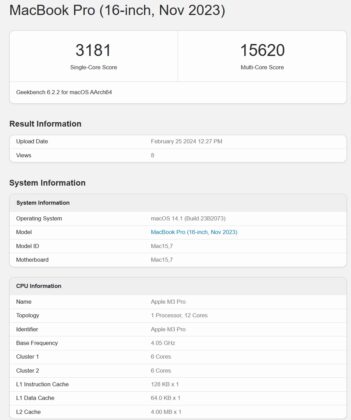Multiple Geekbench listings for a prototype device with a Qualcomm processor named “ZH-WXX,” specifically the Snapdragon X Elite – XE1800, reveal some interesting details. In the leaked tests, a prototype device with the new ARM chip has fetched 12,562 points in multi-core benchmark tests.
We all know Aplpe Silicon M chips for computers are incredibly powerful without consuming too much power. Qualcomm has been trying to build a processor to rival the Apple M lineup for years, and it has been closely working with Microsoft on Windows 11-optimized “Snapdragon X Elite”.
In an earnings call, Qualcomm previously confirmed it’s planning to launch Snapdragon X Elite for Windows 11 in mid-2024 with AI features, and now benchmarks have been spotted on Geekbench. While previous versions of Snapdragon ARM chips failed to beat Apple M, this one outperforms M1 and M2 and is close to M3 performance.

As you can see in the above screenshot, the Geekbench test confirms that the Snapdragon X Elite is a powerful chip with a single-core score of 2,574. It’s a measure of raw processing power for single-threaded apps on a prototype device running early preview builds of Windows 11 version 24H2.
This score represents the performance of a single CPU core when running tasks that don’t benefit from multiple cores.
On the other hand, Snapdragon X Elite has touched a multi-core score of 12,562, which reflects the combined performance of all CPU cores when running multi-threaded tasks, which is essential for workloads that can be parallelized across multiple cores.
The benchmark mentions the “Snapdragon X Elite – XE1800”, which has 12 cores in total – one cluster with eight cores and a second cluster with four cores. This is a typical big.LITTLE architecture, where some cores are optimized for performance while others are optimized for efficiency.
We’ve spotted as many as five listings for Snapdragon X Elite on Geekbench with varying test scores.
Top Result:
- Single-Core Score: 2574
- Multi-Core Score: 12562
This result shows the highest multi-core score among the five, suggesting optimal multi-threaded performance on this date.
Second result:
- Single-Core Score: 2565
- Multi-Core Score: 11778
This shows a slight decrease in both single-core and multi-core scores compared to the top result, possibly due to different system conditions (perhaps a battery saver mode or some other adjustments?).
Third Result:
- Single-Core Score: 2517
- Multi-Core Score: 11010
This benchmark has notably lower scores in both categories compared to the first two, suggesting different test conditions or a less optimized system state.
Fourth Result:
- Single-Core Score: 2548
- Multi-Core Score: 11253
The single-core score is pretty consistent with the other results but still shows strong performance.
Fifth Result:
- Single-Core Score: 2434
- Multi-Core Score: 11351
This is the lowest single-core score among the five, which might indicate thermal throttling.
Snapdragon X Elite vs Apple M3 benchmark comparison
| Chip | Single-core | Multi-core |
|---|---|---|
| Apple M1 | 2334 | 8316 |
| Apple M2 | 2589 | 9742 |
| Apple M3 | 3181 | 15620 |
| Snapdragon X Elite | 2574 | 12562 |
The X Elite chips are faster than the previous generations of Apple M, which shouldn’t be a surprise as Qualcomm’s new processor has more cores.
To compare the Apple M3 (from the MacBook Pro 16-inch, Nov 2023) with the top result of the Snapdragon X Elite, let’s take a closer look at the following data we extracted from Geekbench.
Snapdragon X Elite:
- Single-Core Score: 2574
- Multi-Core Score: 12562
- CPU: Snapdragon X Elite – XE1800 – Qualcomm Oryon CPU with 12 cores (configuration not specified in the comparison).
- Test hardware: Prototype running Windows 11 preview builds.
Single-Core Score: 3181
- Multi-Core Score: 15620
- CPU: Apple M3 Pro with 12 cores and a base frequency of 4.05 GHz.
- Memory: 36.00 GB
- Test hardware: MacBook running stable macOS.
As you can see in the above comparison, the Apple M3 is quicker than the Snapdragon when doing jobs that only need one core. When you have to do many jobs simultaneously (like editing videos, running simulations, or opening many apps), the Apple M3 can also handle more at once.
Both have the same number of cores (12), but the Apple M3 runs at a higher speed (4.05 GHz compared to the Snapdragon’s speed, which is not mentioned here).
While Apple M3 is still much better in these tests, it is important to understand that the leaked Snapdragon X Elite was tested on a device running Windows 11’s unoptimized preview builds.
In other words, the actual hardware will likely produce better results.
The post Windows 11 Snapdragon X Elite benchmark shows Apple M3 performance gap is closing appeared first on Windows Latest


